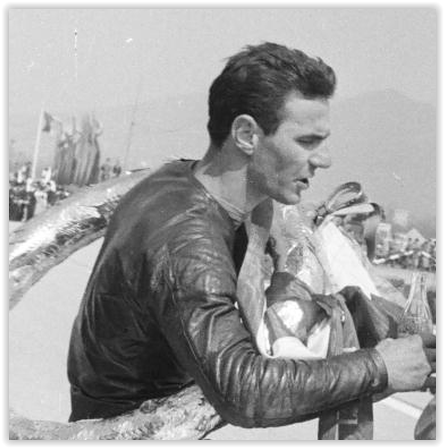
Part 3 about the history of the fast Italian rider
After his first world title in 1951, Ubbiali had extended the contract with FB-Mondial for the next season. In the previous year, all three teammates and compatriots who started with him in the World Cup had lost their lives on the racetrack. For 1952, the works team now consisted of him, the World Championship third from the previous year McCandless and Len Parry.

MV Agusta brought a new model and thus had the means to seriously challenge Mondial for the first time. For the first time in the 4th year of its existence, the motorcycle World Cup deserved this designation after riders from Germany were finally admitted. It should not be long before she and her works should make their mark, especially in the middle classes and sidecars of the World Championship. However, it would be another 9 years before the first race outside of Europe. But at least participants from all countries were now eligible to participate.

Factory teams of the 1952 motorcycle World Championship

Start of the season 1952
While the smallest class still had a break at the Bern Grand Prix and was not advertised at the season opener in Switzerland, Carlo competed in national races. In Faenza and Parma he started very successfully in the Italian 125 cc championship with two victories in a row. This was followed on May 11, 1952, by a victory at the Hockenheim GP, which was not part of the World Cup. It was not to be his last victory in this place.


First 125cc world championship race of the season
The World Championship started for Ubbiali on the Isle of Man, where he shone with second place last year behind local hero Cromie McCandless. Exactly this result he equalized in 1952 and finished second behind Cecil Sandford on MV Agusta. Third was his new teammate Len Parry in front of Cromie McCandless, Angelo Copeta (MV) and Frank Burman (EMC / Puch). The World Cup kick-off was a success, but the new MV worried Carlo and his team a little with such a brilliant start. The first two places remained the same in the Netherlands two weeks later than at the TT. The Dutch GP in Assen was won again by Sandford ahead of Ubbiali and this time Luigi Zinzani came third on a Morini.

Mid-season with the German GP
On the Solitude racetrack, Ubbiali came second in the 125 cc race for the third time in a row this season. But this time the winner was surprisingly Werner Haas, who crossed the finish line just 1.4 seconds before the Italian. The German competed at an NSU, and it should not be long before MV Agusta and Mondial should shudder at these 3 letters.



Bad luck at the Ulster Grand Prix
Cecil Sandford and his MV Agusta had defeated Carlo already two times this season, but in Germany Ubbiali arrived in front of the Brit. The preliminary decision in the world championship fell at the Ulster GP on August 16, 1952, when the latter secured his third win of the season. Sandfords teammate Bill Lomas came in second ahead of Charlie Salt, also on MV. The 3 drivers on the podium were in the end the only drivers classified in the 125 cc race in Northern Ireland. Before that, Ubbiali, who was in third place, had crashed just like MV driver Williams. The Morinis also dropped out and Carlos’ team-mate McCandless was the victim of a technical defect in his Mondial.

Ubbialis home race in Monza
At Ubbialis home race in the 125cc GP of Nations, to the annoyance of the Mondial team, Emilio Mendogni won this time on his Morini. For the fourth time this season Carlo was only second ahead of Leslie Graham (MV), Luigi Zinzani (Morini) and Guido Sala (MV). The German Hubert Luttenberger got the last world championship point with his NSU and rank 6. Sandford then traveled as world champion to the season finale in Spain, the title could no longer be taken from the Englishman.

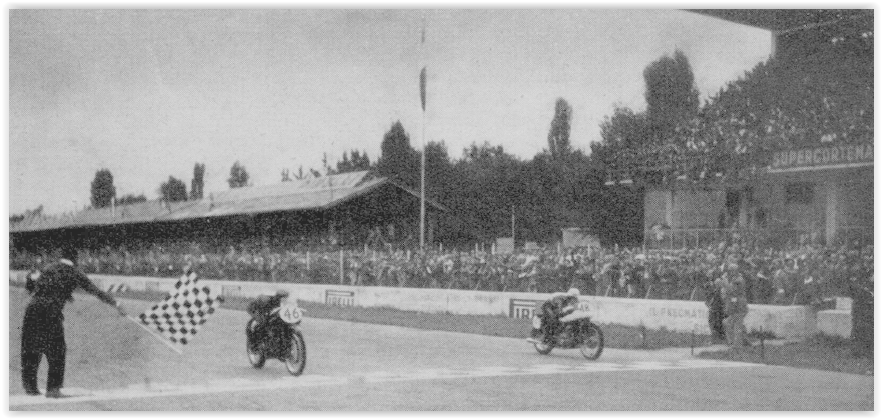

Cecil Sandford – the first World Champ for MV
Despite not having seen the finish line at the race in Monza, Cecil was already in the lead. He went down in history as the first world champion for MV Agusta. With 6 rounds, 1952 was also the first season with a reasonable number of World Championship races. With only 3 races in the first two World Cup years in 1949 and 1950, as well as four races in the 1951 season, the smallest class had finally grown up in this respect too.

The season finale in Barcelona
Mendogni won again in the Montjuic Park of Barcelona, this time ahead of Leslie Graham, Sandford (both MV), Romolo Ferri (Morini) and the German veteran H. P. Müller on NSU. He had to be 43 years old in order to finally get points at a World Championship run. In the first 3 years of the motorcycle world championship he was not even allowed as a German. Carlo missed out on the Spanish GP for the second time this season. At the beginning of the 125 cc final run at the Spanish GP he was still leading, but then got problems early on. After the first lap, Ubbiali only crossed the finish line in 7th position before he was later eliminated entirely. After all, he fared better than Arturo Elizalde (SPA), Bill Lomas (GBR) and Angelo Copeta (ITA), who fell out of the race. The Spaniard Elizalde was the only pilot with a broken arm who sustained serious injuries.


Summary of the 1952 season for Carlo
Because of his four (in total) second places, Ubbiali became vice world champion for the second time after 1950 (at that time ex aequo with Gianni Leoni). For the third time in a row he also won the title of Italian 125 cm³ master for FB Mondial. For the brand from Manerbio in Lombardy, of course, this was a very important aspect. The domestic vehicle market was particularly important for the company founded in 1929 by the Boselli brothers (hence the FB, for Fratelli Boselli). The next season was one of the most important steps in Carlo’s entire career. With his return to MV Augusta, for whom he had already contested the first World Cup season in 1949, his competitiveness also increased. Mondial had withdrawn from the Grand Prix Sport at the factory at the end of 1952, they were to return 4 years later.

125 cc driver world championship 1952
After only the first 6 drivers of a race were able to win championship points at that time, here are also the drivers who finished 7th to 10th in a GP (with the country codes customary at the time):
B. Falconi (I, MV Agusta), H. Grindley (IRL, DMW), E. Hardy (GB, Dot), Tonnie Heinemann (NL, Eysink), Ewald Kluge (D, DKW), José Maria Llobet (E, Montesa), Karl Lottes (D, MV Agusta), Noel Mavrogordato (GB, EMC/Puch), Alex Mayer (A, FB-Mondial), Rudi Meister (D, FB-Mondial), Alfonso Mila (E, Montesa), Nello Pagani (I, FB-Mondial), Dick Renooy (NL, Eysink), Dick van der Waerdt (NL, Eysink), Ton van Zutphen (NL, Eysink), Mobi Vierdag (NL, Eysink), H. Williams (GB, BSA).
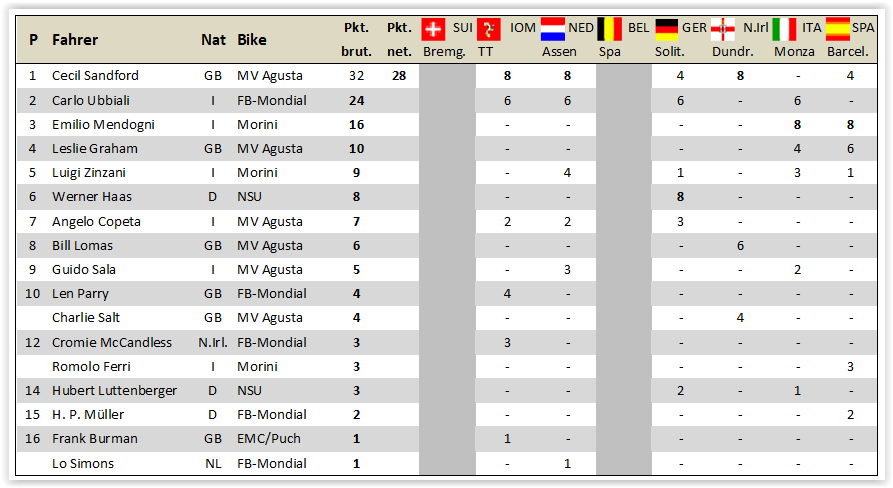
125cc manufacturers’ world championship in 1952

The 1953 season & the return to MV Agusta
As already mentioned in the first part of our story about Carlo Ubbiali’s career, the motorcycle world championship was a fraudulent label in the first 3 years of its existence. The many strong drivers from Germany were not even allowed at that time. As a result, their works stayed away from the Grand Prix two-wheeler scene, which of course changed suddenly from 1952. And after a first season with surprising home victories by Werner Hass with NSU in the 125s and Rudi Felgenheier (DKW) in the 250cc class, various German manufacturers “smelled the roast”.

The new power in the smaller classes
Only one year after Mondial left, MV Agusta suddenly became a strong new opponent for 1953 with NSU. At the beginning the works team in the 125 cm³ class consisted of 4 drivers. But one of them was tragically eliminated in the first round of the World Cup. For this reason it is not listed in the following table at MV.
The factory teams of the 1953 motorcycle world championship

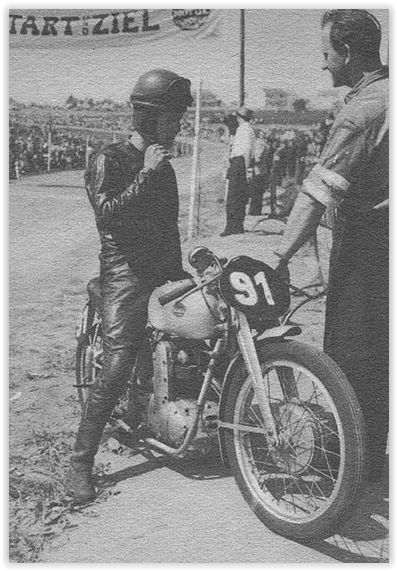
Season opener with Ubbialis false start
Carlo was in fourth place at the first World Championship run of the season on the Isle of Man when he had to stop and give up the race due to a break in the oil pipe on his MV. The Italian had not come two laps before. After two rounds it was already clear who would win this first round of the World Cup if he was not eliminated. With Leslie Graham, it was the veteran of the newly formed works team who, after 2 laps, was already leading with a lead of 38 seconds over second placed team-mate Cecil Sandford.

Exciting decision in the last few laps
The German Haas at his NSU was almost a minute behind Graham at this point. But on the third and final lap of the more than 60 km long Snaefell Mountain Course, Werner Haas fought his way past Sandford and took an excellent second place ahead of the MV pilot. Unfortunately, winner Graham could not look forward to his triumph for long. It was a drama that happened to him just two days later in the 500 run.

GP of the Netherlands with a superior Werner Haas on NSU
The Dutch TT in Assen took place on a completely different route than the highly dangerous street circuit on the Isle of Man. After Cecil Sandford had dominated the 125 cm³ race last year, it was Werner Haas this time. The German NSU driver won with a 47-second lead over Ubbiali and already 1 minute 26 seconds ahead of last year’s winner from England in 3rd place. 4th place went to Zinzani on the best Morini, ahead of his brand colleague and local hero Drikus Veer and Lo Simmons (Mondial). Haas was now world championship leader ahead of Sandford with the same number of points as the late Graham. Ubbiali was third, but after 2 of 6 World Championship rounds he could still hope for the World Championship title. At the next Belgian Grand Prix in Spa-Francorchamps, the smallest category had a break. It only continued again in Germany with the Schottenring premiere.

Ubbialis victory at the German Grand Prix
The second German GP took place on the Schottenring for the first and only time in 1953. Carlo Ubbiali had only lost the victory by a hair’s breadth against Haas on July 20th at the Solitude last year. Therefore, the northern Italian in Schotten was naturally eager to take revenge at the German Grand Prix. Especially after he had bad luck at the World Cup opener at the TT and was defeated for the second time in the next round against Haas in Assen. So this time Carlo really wanted to win.

On a wet track like a ride on a cannonball
The start had been postponed by three quarters of an hour. The reason for this was that the track was still too wet and slippery. Naturally, it quickly became life-threatening on the Schotten road. In addition, there had been protests in advance about the dangerousness of the route. Gilera and Norton had even withdrawn from the race and boycotted this championship run. But this did not affect the smaller classes and so it got down to business with a short delay. After initial reluctance, Carlo fought his way up one place after another. In the end he beat all opponents and crossed the finish line first, ahead of Haas and Daiker on the two NSUs and team-mate Copeta in fourth.
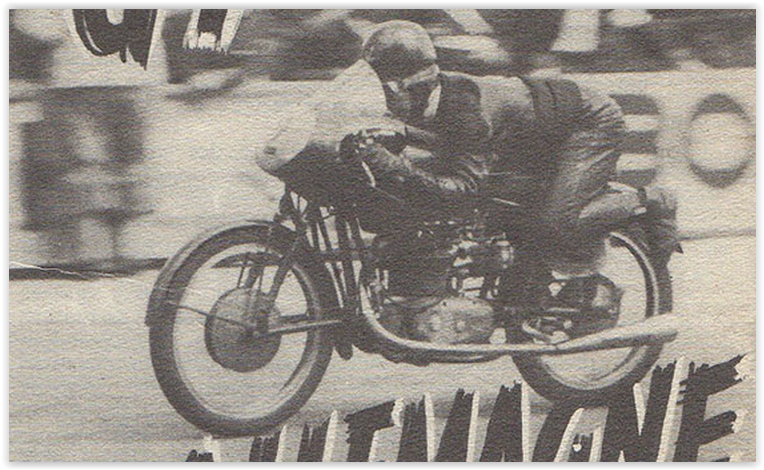

The second half of the 1953 season
From Ubbiali’s point of view, the story of the Ulster GP was quickly told. Carlo had already exaggerated it in training and had flown through a hedge, where he had broken two metatarsal bones. In the absence of the injured Italian, Haas won ahead of Sandford and Armstrong and was able to significantly increase his lead in the intermediate championship ranking.
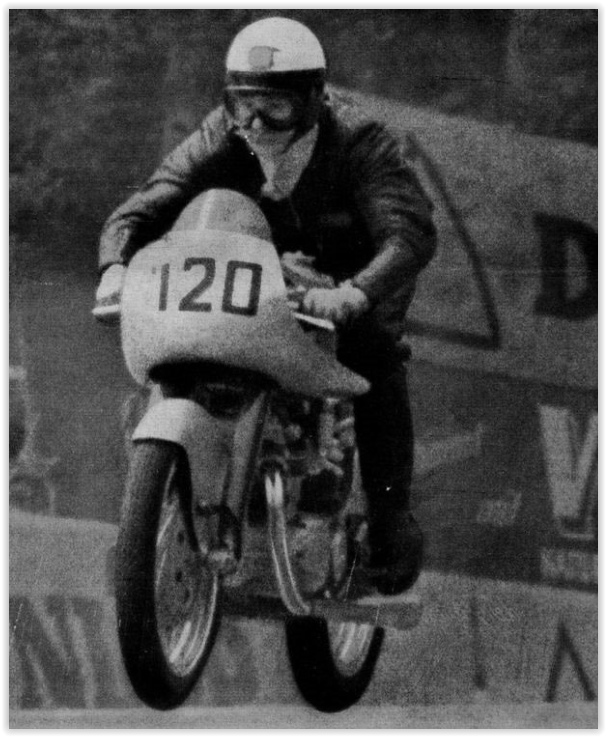
The second half of the 1953 season
In Carlo’s home race in Monza, Haas again won ahead of Mendogni (Morini) and Ubbiali. The German had his first World Cup title safe before the season finale in Barcelona. At the World Cup final in Montjuic Park, the Italian Copeta won ahead of Cecil Sandford (both MV) and Rupert Hollaus on NSU. The Austrian was a new member of the NSU factory team and should cause quite a sensation next year. Haas crashed at the Spanish GP, but luckily he was uninjured. The meanwhile leading Ubbiali fell back to 7th place in the end.

Conclusion of the 1953 season for Carlo Ubbiali
Due to the disappointing 7th place at the season finale in Barcelona, Carlo lost the runner-up world title to his team-mate Cecil Sandford in the last race and was third in the World Championship. Werner Haas had not only won the 125 title, but also became world champion in the 250 cm³ class in 1953. In total, he took 5 wins in the two smaller categories this season. Ubbiali, on the other hand, was only once on top of the podium this year. For the first time in 3 years, the title of Italian 125 cc master in 1953 with Emilio Mendogni (Moto Morini) did not go to Ubbiali. MV Agusta was able to add a little over the course of the season. Among other things, the 125 series was converted from magnetic to battery ignition. But even the 1954 Grand Prix season should not be a piece of cake for Carlo and his team.

125cc riders World Championship 1953
After only the first 6 drivers of a race were able to win championship points at that time, here are also the drivers who finished 7th to 10th in a GP (with the country codes customary at the time):
Georges Burgraff (F, MV Agusta), Harold Clark (GB, MV Agusta), Roberto Colombo (I, NSU), Gabriel Corsín (E, MV Agusta), Wout de Greef (NL, NSU), Archie Fenn (GB-FP-Mondial), Xaver Heiß (D, Puch), J. Hogan (GB, EMC/Puch), Erhard Krumpholz (DDR, IFA), Hubert Luttenberger (D, MV Agusta), Joaquin “Pinquino” Sagnier (E, Montesa), Fron Pruslow (GB, MV Agusta), Juan Soler Bultó (E, Montesa), James Thomson (GB, MV Agusta), Dick van der Waerdt (NL, Eysink), Norman Webb (GB, MV Agusta).

125 cm³ Manufacturers World Championship 1953
In the event of a tie, the times of the best driver of the two brands were added up to determine the winner in the manufacturers’ championship. Taken together, this gave MV Agusta a lead of 36 seconds over NSU.

Part 4: http://www.motoracers.eu/carlo-ubbiali-story-part-4/?lang=en

No Comments Yet